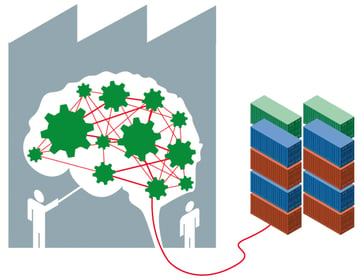Struggling with Intelligent Planning? Postmodern ERP Can Help
Brian Hoey - March 27, 2018

 With a name like “intelligent planning,” it’s hard to imagine that many companies would express a strong preference to do the opposite. And yet, despite intelligent planning’s status as a potential value-added proposition with the ability to smooth out production and transport workflows, many businesses have been slow to implement smarter scheduling and operational planning processes. The reason for this is simple: many modern manufacturers are stuck in the past when it comes to data visibility and planning workflows. Production plans created with pen and ink or Excel spreadsheets can never provide the level of agility, flexibility, or transparency that a lean supply chain requires, but many companies’ planning workflows are unable to evolve do to widespread planning silos and shadow IT.
With a name like “intelligent planning,” it’s hard to imagine that many companies would express a strong preference to do the opposite. And yet, despite intelligent planning’s status as a potential value-added proposition with the ability to smooth out production and transport workflows, many businesses have been slow to implement smarter scheduling and operational planning processes. The reason for this is simple: many modern manufacturers are stuck in the past when it comes to data visibility and planning workflows. Production plans created with pen and ink or Excel spreadsheets can never provide the level of agility, flexibility, or transparency that a lean supply chain requires, but many companies’ planning workflows are unable to evolve do to widespread planning silos and shadow IT.
For manufacturers or freight forwarders, eliminating silos and shadow IT can be the most significant hurdles to adopting an intelligent planning mindset. Until that happens, supply chain planners will necessarily have to work with an incomplete picture of their current demand realities, inventory usage, and other mission critical organizational workflows. While remedying this situation often requires widespread changes, a useful first step for many businesses is the adoption of a Postmodern ERP mindset.
What is Postmodern ERP?
Now, you may be thinking, what does Postmodern ERP have to do with eliminating silos? The easiest way to understand that is with a quick refresher on Postmodern ERP as a concept. In many ways, it can be described as a shift away from modern ERP (in which one monolithic software solution is meant to cover all business functions) and back towards “best-of-breed,” but with crucial improvements in terms of interconnectivity and scalability. For example, a product like Salesforce might be adopted by a given company’s sales team; though other branches of the business would make use of their own respective IT solutions, their systems would be easily integrated with that of the sales department, resulting in increased intra-operational visibility.
The value of this type of approach is that different departments are able to adopt the IT solutions that best suit their needs without having to resort to implementing Shadow IT. Since the various solutions, though de-centralized, are ultimately integrated and connected, disparate points on the value chain are now given insights into one another’s processes and data collection, meaning that supply chain planners can finally access the mission critical data that their operational plans require.
The Power of Visibility
With a Postmodern ERP mindset, all of the mission critical data gathered across various touchpoints on the value chain gains a new degree of visibility, paving the way for increased integration of more sophisticated technological workflows. While businesses that fail to maintain a centralized cache of usable reporting data often face considerable difficulty when it comes to integrating smarter planning processes, manufacturers and freight forwarders that have successfully increased their supply chain visibility stand to add value in a number ways:
- Users can gain a more holistic picture of past demand in order to facilitate more effective future demand planning
- More visible sales forecasts can help inform production plans that better reflect intra-organizational expectations
- Disparate business operations can be leveraged towards common goals, helping to create more efficient workflows and prevent future bottlenecks and breakdowns
- Decreased decision-making silos can help to drive a concurrent decrease in communication failures across the supply stream.
From Past to Future
Increases in visibility make it easier to reference past demand in a meaningful way, contributing to a more holistic view of how all touchpoints on the value chain interact with one another. While the past is frequently instructive, it does have its limitations, especially when it comes to predicting the outcomes of potential process changes and foreseeing significant demand shifts or market disruptions. For many businesses, the adoption of advanced analytics can help create more future-oriented supply chain planning. Intelligent planning solutions backed by sophisticated prescriptive and predictive analytics solutions offer businesses the opportunity to create more accurate forecasts and implement value additive changes to various production and logistics processes.
To fully take advantage of intelligent planning in this way, a robust IT infrastructure is an absolute necessity. In terms of ERP, this means that siloized and otherwise disconnected technological infrastructure won’t be able to support your attempts at integrating more future-focused analytical information into supply chain workflows. In the modern ERP era, this kind of siloization would have been common enough to make advanced analytics integration an impossible hurdle for many businesses. With a Postmodern ERP approach, on the other hand, data from disparate business functions can be gathered, centralized, and ultimately turned into crucial business insights that can help reduce bottlenecks and bolster revenue.
LATEST POSTS
- Understand Circular Economy in The Manufacturing Industry
- How Can Industry 4.0 IT Integration Be Achieved Smoothly?
- The Significance of Order Sequencing in Discrete Manufacturing
- How to improve your Supply Chain Management: The Power of Control Towers
- Optimizing Human Resource Scheduling in Manufacturing: A Technological Approach



